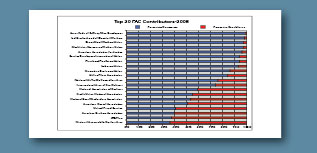| The Hydra was a nine-headed beast in Greek mythology. Hercules was tasked with killing the monster, only to find that when he cut off one head, two grew in its place. |
| |
| Corporations should feel like Hercules when they realize big labor is employing a Hydra strategy to not only regain waning power and membership, but to take a dominant role in the global business community. |
| |
| It starts with regaining political clout, and that means campaign spending. The AFL-CIO has approved a political budget of $53 million, and its affiliated unions have pledged an additional $200 million. The National Education Association (i.e., the teachers’ union) will spend an estimated $40-$50 million, and the fast-growing Service Employees International Union (SEIU) will spend another $100 million. (More on the SEIU below.) |
| |
| Eleven of the top 20 PAC contributors thus far in 2008 are labor unions, and 74% to 99% of their PAC dollars are going to Democrats. The other major left-leaning PAC is the American Association for Justice, the warm-and-fuzzy name under which the Trial Lawyers are rebranding themselves.
(See chart below.) |
| |
 |
| [Place cursor over graph to enlarge] |
| |
| But political spending and support for Democratic candidates is just one element of the Hydra strategy. Organized labor in general, and certain unions specifically, are engaged in a broad battle on many fronts to reverse the long slide in union membership. A few of these initiatives include: |
| |
 |
Rewriting NAFTA to protect jobs in the U.S. |
| |
|
 |
Mandating health care reforms to include universal coverage |
| |
|
 |
Passage of the Employee Free Choice Act, which will abolish secret ballot union certification elections and use card check as the means to gain recognition as the exclusive bargaining agent for workers |
| |
|
|
|
|
|
 |
Striking down right-to-work legislation, which would mean forced unionization in the 22 states that now leave membership up to the individual worker |
| |
|
 |
Insertion of Davis-Bacon wage requirements in every piece of significant legislation considered by Congress. These wage rates can be twice the market rate. |
| |
|
 |
Aligning with other special interest groups to achieve their organizing goals. One such example is the strange-bedfellows relationship between the Teamsters and the Natural Resources Defense Council (NRDC). The Teamsters want the ports of Long Beach and Los Angeles to restrict port access to drivers employed by hauling companies, rather than independent owner-operators. Why? Because trucking company employees are easier to organize than individual drivers. |
| |
|
| |
What’s in it for the NRDC? The Council wants to keep the older vehicles driven by owner-operators out of the ports because they pollute more than the newer vehicles larger trucking companies supposedly use. |
|
| |
| The SEIU is arguably employing the most sophisticated tactics to grow membership, with an objective to add 500,000 members by 2012. A few examples of the union’s efforts: |
| |
 |
Though ultimately unsuccessful, the union came close to getting the California legislature to pass a law that would have made it easier for the SEIU to organize certain companies owned by targeted private equity firms. |
| |
|
 |
Andy Stern, president of the 1.7 million member union, is introducing plans to dramatically shift money, union organization, and negotiations with large corporations away from union locals, consolidating it in the hands of its international headquarters. |
| |
|
|
| Given the numerous challenges facing corporate leadership today (e.g., a weak economy, surging fuel prices, and skyrocketing health care costs), corporate leadership appears to be taking a time out from fighting these union initiatives. |
| |
| The economy will eventually get better, fuel costs will level off and health care will be dealt with one way or another. But it will be very difficult to beat back the Hydra if organized labor is successful in getting the Employee Free Choice Act passed, or succeeds in these other initiatives. |
|